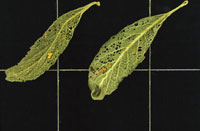Tricholochmaea decora
Hosts
Elm, Fruit trees, Poplar and Willow
Appearance and Life Cycle

Photo credit: AAFC-Agroforestry Development Centre
An insect that periodically becomes a destructive pest of poplar and willow in the prairies is the gray willow leaf beetle. The beetles are about 5 mm in length and are a greyish-brown colour. In early May, adults emerge from their overwintering sites and feed on the foliage of poplar and willow species. From early May to early June the beetles migrate in large numbers, rarely feeding in one location for more than a week. Mating generally begins in late May, with egg laying occurring from June to early July. Small, round, yellowish-orange egg clusters of approximately 15 are deposited on the rough bark of the stems of native willow. Hatching of the larvae occurs within two weeks. The newly hatched larvae are creamy-yellow at first, later changing to almost black in colour. In late July or early August, the full grown larvae, measuring 8 mm in length, drop to the ground. The larvae tunnel into the soil transforming into pupae. The adults emerge in approximately two weeks and begin feeding on poplar foliage. The adults feed for a short time before overwintering in leaf and soil debris. There is only one generation a year of the gray willow leaf beetle.
Damage

Photo credit: AAFC- Agroforestry Development Centre
The most serious damage occurs during migration, when masses of beetles skeletonize the leaves of host trees. Feeding by larvae also causes damage, turning the leaves a rusty-brown colour, giving them a scorched appearance.
Control
Chemical control of the gray willow leaf beetle is rarely required due to natural mortality from parasites which attack the larval stage. If a severe outbreak does occur, spray with carbaryl at the first sign of damage.